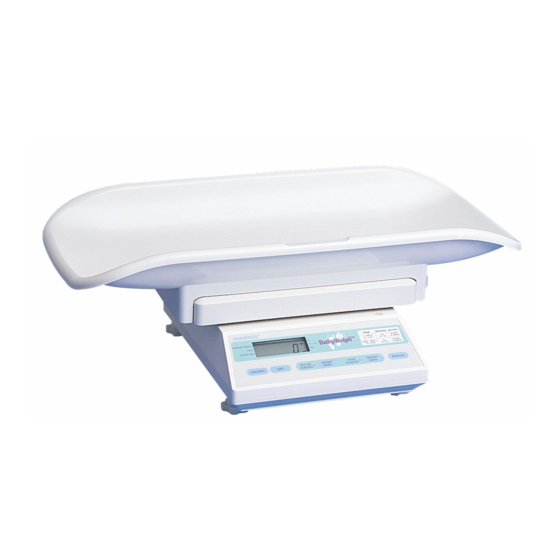Table of Contents
Advertisement
www.medela.com
Medela, Inc.
P.O. Box 660, 1101 Corporate Drive
McHenry, IL 60051-0660 USA
Phone: (800) 435-8316
Fax: (815) 363-1246
Email: customer.service@medela.com
BabyWeigh, Supplemental Nursing System and SNS are trademarks and
Medela is a registrated trademark of Medela, Inc.
1907181 C 1109
©2009 Medela, Inc.
Advertisement
Table of Contents

Summary of Contents for Medela BabyWeigh
- Page 1 P.O. Box 660, 1101 Corporate Drive McHenry, IL 60051-0660 USA Phone: (800) 435-8316 Fax: (815) 363-1246 Email: customer.service@medela.com BabyWeigh, Supplemental Nursing System and SNS are trademarks and Medela is a registrated trademark of Medela, Inc. 1907181 C 1109 ©2009 Medela, Inc.
- Page 2 BabyWeigh scale parents’ instructions...
- Page 3 Congratulations on making the decision to breastfeed your baby! Research shows that mothers’ milk provides babies with the ideal nutrition for growth and extra protection from infection, allergies and some chronic diseases. Sustaining breastfeeding requires commitment on your part, but these efforts represent an important contribution to your baby’s health.
-
Page 4: Table Of Contents
How should Test-Weights be recorded? ......6 How do I know if my baby needs additional milk? ....6 How long will I need to use the BabyWeigh scale? .... 7 Additional questions about Test-Weighing ....8-10 Closing comments ............10 Performing Test-Weights with the BabyWeigh scale ...11-12... - Page 5 The BabyWeigh scale operates with an electrical adapter or with 6 “C” alkaline batteries. electrical adapter input For further information on the operation of the BabyWeigh scale, see the operator’s manual.
-
Page 6: Scale
BabyWeigh scale to help you with breastfeeding during the first days or weeks that you are home with your baby. The BabyWeigh scale allows you to measure the amount of milk your baby consumes during breastfeeding, simply by weighing your baby on the scale before and after the feeding. -
Page 7: What Is Test-Weighing
Commonly, a supplement is used when the mother and baby are separated during a feeding time. Use of the BabyWeigh scale will help you and your pediatric care provider decide how much additional milk to use as a complement or supplement to breastfeeding. -
Page 8: What Is Unique About The Babyweigh Scale
A special feature of the BabyWeigh scale is that it automatically subtracts the “before” from the “after” weight, and displays this calculation in an easy-to-read digital format. Additionally, the... -
Page 9: Are There Any Safety Precautions With Test-Weighing
Are there any safety precautions with Test-Weighing? You should place the BabyWeigh scale on a flat, stable surface such as a kitchen table that is wider and longer than the scale. The base of the scale should not extend over the flat surface of the table, and the scale should not wobble or jiggle. -
Page 10: How Do I Perform Test-Weights
Even a bootie, hat, or a pacifier that is present for one procedure and not the other will make test-weighing less accurate, because the BabyWeigh ™ scale is so sensitive to small changes in weight. Remember that the test-weights may be several hundred grams larger than your baby’s routine (nude) weight, because of the clothing and... -
Page 11: How Should Test-Weights Be Recorded
How should Test-Weights be recorded? All test-weights, complements, and supplements should be recorded on a milk intake record. An example of a milk intake record, which you may use for your baby, is included at the end of this booklet. Depending on your individual breastfeeding situation, your lactation consultant or your pediatric care provider may give you a different form for recording milk intake. -
Page 12: How Long Will I Need To Use The Babyweigh Scale
BabyWeigh scale? ™ The length of time that parents use the BabyWeigh scale will vary with each breastfeeding situation. In some instances, parents may need to use the BabyWeigh scale for only a few days, and perhaps only for routine daily weights, rather than for 24-hour test-weights. -
Page 13: Additional Questions About Test-Weighing
As a final step, you may wish to stop performing test-weights and use the BabyWeigh scale to measure a routine (nude) weight for your baby each day. After you have seen a steady pattern of daily weight gain for several days and have reviewed this pattern with your pediatric care provider, you should not need to use the BabyWeigh scale any longer. - Page 14 What if my baby spits up or drools milk during a feeding? If your baby spits up or drools milk during a feeding, you may want to use a cloth diaper as a bib. Do not include the bib in either the “before”...
-
Page 15: Closing Comments
We hope that you will find the BabyWeigh scale a source of comfort and reassurance as you and your baby develop your own special breastfeeding relationship! This booklet was written by Dr. -
Page 16: Performing Test-Weights With The Babyweigh Scale
Performing Test-Weights with the BabyWeigh scale ™ A. Check that the scale is on a flat surface and does not jiggle or wobble. Use the level indicator on the scale to check your flat surface. B. Dress your baby in the clothes and/or blankets to be worn for breastfeeding. - Page 17 I. Remove the baby from the scale, press and hold the “WEIGHT GAIN” button and the scale will calculate milk intake (in milliliters or cubic centimeters). This value will appear in the digital display. J. When you remove your finger from the “WEIGHT GAIN” button, your baby’s “after”...







Need help?
Do you have a question about the BabyWeigh and is the answer not in the manual?
Questions and answers